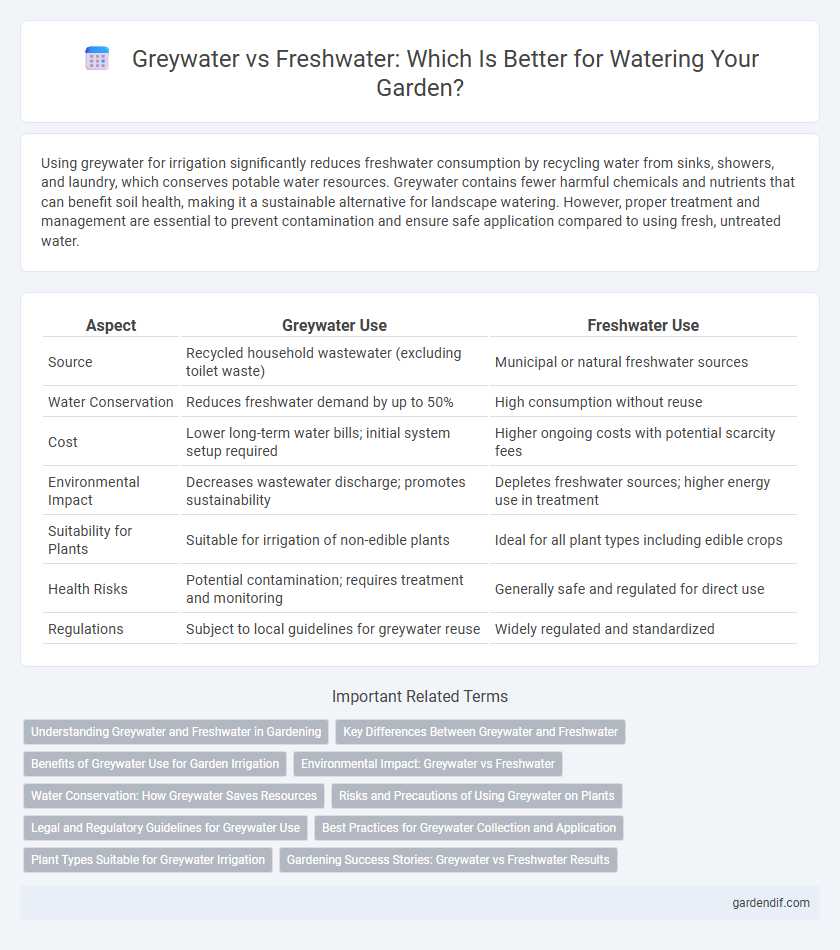
Greywater use vs Freshwater use Illustration
Using greywater for irrigation significantly reduces freshwater consumption by recycling water from sinks, showers, and laundry, which conserves potable water resources. Greywater contains fewer harmful chemicals and nutrients that can benefit soil health, making it a sustainable alternative for landscape watering. However, proper treatment and management are essential to prevent contamination and ensure safe application compared to using fresh, untreated water.
Table of Comparison
| Aspect | Greywater Use | Freshwater Use |
|---|---|---|
| Source | Recycled household wastewater (excluding toilet waste) | Municipal or natural freshwater sources |
| Water Conservation | Reduces freshwater demand by up to 50% | High consumption without reuse |
| Cost | Lower long-term water bills; initial system setup required | Higher ongoing costs with potential scarcity fees |
| Environmental Impact | Decreases wastewater discharge; promotes sustainability | Depletes freshwater sources; higher energy use in treatment |
| Suitability for Plants | Suitable for irrigation of non-edible plants | Ideal for all plant types including edible crops |
| Health Risks | Potential contamination; requires treatment and monitoring | Generally safe and regulated for direct use |
| Regulations | Subject to local guidelines for greywater reuse | Widely regulated and standardized |
Understanding Greywater and Freshwater in Gardening
Greywater, the gently used water from sinks, showers, and laundry, offers a sustainable alternative to freshwater for gardening by reducing demand on potable water supplies. Freshwater sourced from rivers, reservoirs, and aquifers remains essential for high-quality irrigation, especially for edible plants requiring low contamination risk. Understanding the differences in nutrient content, potential contaminants, and irrigation methods between greywater and freshwater is crucial for optimizing plant health and conserving resources in sustainable gardening practices.
Key Differences Between Greywater and Freshwater
Greywater originates from household sources like sinks, showers, and laundry, containing fewer contaminants than blackwater but more than freshwater, making it suitable mainly for irrigation and non-potable use. Freshwater, sourced from rivers, lakes, and aquifers, is treated to meet drinking water standards and supports all uses including consumption, agriculture, and industrial processes. Key differences lie in their treatment requirements, potential health risks, and environmental impact, with greywater reuse significantly reducing freshwater demand and conserving water resources.
Benefits of Greywater Use for Garden Irrigation
Greywater use for garden irrigation reduces freshwater consumption by recycling water from baths, sinks, and laundry, conserving up to 50-60% of household water. It enriches soil nutrients by retaining organic matter and trace elements, promoting healthier plant growth compared to freshwater. Implementing greywater systems decreases strain on municipal wastewater treatment plants, lowering environmental impact and water bills simultaneously.
Environmental Impact: Greywater vs Freshwater
Greywater reuse significantly reduces freshwater consumption by recycling water from baths, sinks, and laundry for irrigation, decreasing the strain on natural freshwater sources and aquifers. Compared to freshwater, greywater contains biodegradable contaminants that, when properly treated, can enhance soil moisture and nutrient levels, promoting healthier plant growth while minimizing chemical fertilizer use. However, improper greywater management risks soil salinization and pathogen exposure, necessitating effective treatment systems to ensure environmental safety and sustainability.
Water Conservation: How Greywater Saves Resources
Using greywater for irrigation significantly reduces freshwater consumption by recycling water from baths, sinks, and laundry, lowering overall water demand. Greywater systems can save up to 50% of household water, easing the strain on municipal supplies and groundwater resources. Efficient greywater reuse promotes sustainable landscaping and decreases the energy footprint associated with freshwater treatment and distribution.
Risks and Precautions of Using Greywater on Plants
Greywater reuse for irrigation reduces freshwater consumption but carries risks such as soil salinization, pathogen contamination, and chemical buildup that can harm plant health. To minimize these risks, treat greywater through filtration and avoid using it on edible plants or sensitive crops, ensuring soil pH and salinity are regularly monitored. Proper management includes diluting greywater and rotating with freshwater irrigation to maintain soil quality and prevent long-term damage.
Legal and Regulatory Guidelines for Greywater Use
Legal and regulatory guidelines for greywater use vary significantly by region, often requiring treatment and specific application methods to ensure safety and environmental protection. Many jurisdictions mandate greywater systems to comply with local plumbing codes and health regulations, limiting its use to subsurface irrigation and prohibiting direct contact with edible crops. Regulations typically emphasize preventing cross-contamination with freshwater supplies, mandating permits and regular monitoring for system maintenance and water quality standards.
Best Practices for Greywater Collection and Application
Greywater use for watering reduces freshwater consumption, conserving valuable resources while supporting sustainable landscaping. Best practices for greywater collection include diverting laundry and shower water through filtration systems to remove contaminants and prevent clogging of irrigation lines. Applying greywater directly to the root zone of drought-tolerant plants using drip irrigation ensures safe and efficient water use, minimizing health risks and environmental impact.
Plant Types Suitable for Greywater Irrigation
Greywater irrigation is ideal for drought-tolerant plants such as succulents, native shrubs, and certain fruit trees that can handle moderate levels of salts and nutrients present in greywater. Avoiding delicate plants like leafy greens and herbs reduces the risk of contaminant uptake and ensures healthier growth. Using greywater for established ornamental plants and trees supports water conservation without compromising plant health when proper filtration and application methods are followed.
Gardening Success Stories: Greywater vs Freshwater Results
Gardening success stories reveal that using greywater can support plant growth nearly as effectively as freshwater, while significantly reducing potable water consumption. Studies show that greywater irrigation maintains soil moisture and nutrient levels beneficial for diverse garden types. Homeowners report healthier plants and cost savings, highlighting greywater's sustainable impact compared to traditional freshwater use.
Greywater use vs Freshwater use Infographic

 gardendif.com
gardendif.com